Kite Design
This page traces some of the history of sport kite design and my involvement since 1995. It covers the evolution of trick and freestyle kites leading up to the Gemini, Airbow and Deep Space that I designed with Tim Benson of Benson Kites.
I started flying kites in 1995 at the time that trick flying was taking off in the UK. The thing that started it was a new kite, or rather, a new kind of kite, called the Stranger. Designed by Andy Preston and maufactured by Flexifoil, this was the first real trick kite.
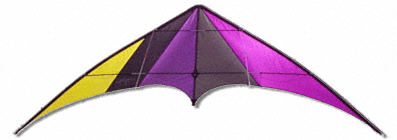
|
| Stranger |
The Stranger wasn't the first kite that could do tricks, nor was Andy Preston the first to do them. The Axel, for example, the most fundamental of all kite tricks, was invented by Steve Thomas in 1992. However, the Stranger was the first kite specifically designed to do tricks. It had a degree of instability that opened the door to a whole new way of flying a kite. And best of all, the kite came with a video that showed Andy Preston and Paul Latham flying it in this entirely new style.
That was when trick flying was born and with it came a change of emphasis. Out went stable, reliable and predictable kites and flying styles. In came radical tricks and an exploration of new and unexpected ways to fly, stall, spin and flip a kite around the sky, on the ground, in a tunnel or off the back of a ship. Andy Preston broke the rules and gave us something new.
I had been flying kites for only a month or so when I first got to try a Stranger. I had been reading about the Axel on the rec.kites newsgroup and struggling to do it on a kite that just didn't make it easy. When I picked up the Stranger, it was suddenly so easy. The kite danced to life in my hands and I could do the things I had been dreaming of. That was the moment when it really began for me.
A week later I had my own Stranger and I flew it compulsively at every opportunity. Unlike the previous kites that I had flown, that you could more-or-less master after a couple of hours flying, the Stranger would go on forever, surprising you, giving you new ideas, inspiration, and ultimately, new tricks. One trick that I particularly liked was the very slick 180 Flat Spin to landing that Andy performs in the video. I soon discovered that it was possible to get an extra rotation in there before flying off - the 540 Flat Spin. Just three months after flying my first proper sport kite, I found myself at Brighton kite festival showing none other than Andy Preston himself how to do it on the Stranger. I was stoked.
And that was another important aspect of what kite flying was really about - the scene. It was a bunch of friendly people hanging out together, flying, jamming, inventing new tricks and different combinations. My local scene was at Epsom Down in Surrey, where I flew with Garry Pullinger, Graham Piggot, Lee Lindstrom, Paul Hankin, and many other great fliers and generally nice people to be around. There were many other places around the UK where similar groups of people were switching onto the new style of flying. The weekend kite festivals throught the summer months and local league competitions in the winter gave fliers a chance to meet up and mingle with other groups, exchanging ideas and making new friends.
Trick flying had brought new life to kite flying. It attracted new fliers into the sport and provided existing fliers with new places to explore. A golden age of kite flying had begun - the trick revolution.
Not long after I got my first Stranger, I heard rumours of a kite that was even more radical than the Stranger, the Box of Tricks.

|
| Box of Tricks |
The Box of Tricks was one of a range of three kites designed by Tim Benson. The Box of Tricks was released in the early months of 1995, and its smaller brother, the Reflex, shortly afterwards. The larger kite of the range, the Fusion, arrived later that year. They were also designed with the same principles in mind as for the Stranger - for trick oriented flying.
So, hot in the middle of my love affair with the Stranger, I found myself falling in love with another kite. The Box of Tricks is indeed more tricky than the Stranger, by virtue of being slightly smaller and feeling lighter to the touch. The Stranger still excelled at the more lazy, relaxed style of trick flying, but the Box of Tricks was for me, better suited to more technical tricks.
And technical was where it went from there. I started exploring the possibilities with the Box of Tricks, learning and inventing new tricks and putting them together in ever more complex combinations. The skill levels and repertoire of trick fliers around the world grew rapidly in those first few years. One of the important factors was the cross-talk of information on rec.kites which helped to quickly establish new ideas in kite flying. Someone could invent a new trick one day and people on the other side of the Atlantic would be flying it the next.
At the same time I was also playing around with different bridle modifications, trying to get better performance out of the kites, particularly with regard to trick flying. I started with a simple dynamic bridle that I had read about on rec.kites and tried to figure out how it was working and what affect it was having on the way the kite handled. Having got my head around that, I started trying out new ideas and thus began a quest for the perfect bridle - a journey that would last many years, and one which is all documented in the Bridle Design section of this web site.
So at the end of August 1995 when I attended Portsmouth kite festival I was heavily into trick flying and already dabbling in bridle modifications. It was there that I met Tim Benson and got to fly with him and talk about bridles and other kite stuff. He offered me a sponsorship deal pretty much there and then and of course, I jumped at the chance. That was the beginning of a great friendship and a design partnership that lasts to this day.
Throughout the winter of 1995/1996 I flew in a local league that tested precision flying. Although it wasn't as much as fun as trick flying, it was an important chance to hone new skills and experience different styles of kite flying.
My kite of choice for competition flying was the Phantom Elite, a modernised version of Tim's classic kite, the original Phantom. Although it is fundamentally a precision kite primarily designed for the rigourous demands of competition flying, the enhanced version was also created with tricks in mind. Although not as radical as a dedicated trick kite like the Box of Tricks, owing to its larger size and straighter leading edges, it will still perform many classic tricks including Axels and Flat Spins.
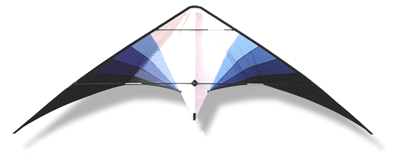
|
| Phantom Elite |
I tried out a number of different bridle designs for this kite, and in doing so discovered the secret of coaxing a kite into flying continuous Axels and Flat Spins. Having learnt the basic technique on this kite, it was easy to apply it to other kites, and a whole new class of tricks became possible.
Having made something of a name for myself as this hot new flier sponsored by Benson Kites, I got the opportunity to go out to the Wildwood kite festival in New Jersey, USA. In May 1996 I took a stack of Benson kites with me and went to show our American friends some of the things we were doing on our side of the pond, and also to find out what they were up to.
While I was there, Curtiss Mitchell and Jeff Howard taught me how to fly a kite indoors. Yes, you can fly a kite indoors, but there aren't any fans or windows left open to provide a breeze. Instead you must make your own wind by walking around with the kite. Large and sweeping arm movements are required to gently apply smooth and continuous pressure to the kite, letting it float and glide wherever possible. This is very much in contrast to how a kite is flown outside where your hands are kept down by your side, leaving the wind to do most of the work.
The other critical factor is the kite. You must have a kite that has been specially designed for zero wind indoor flying or you stand very little chance of getting it off the ground. At Wildwood I had been particularly impressed by the kite Curtiss had lent me to fly. It was a custom Synchro by Herb Weldon - an ultralight kite modelled on the Millenium by Dean Jordan. It was very flat, very light, very sleek and a delight to fly.
As soon as I got back from Wildwood I was on the phone to Tim begging him to make me an indoor kite. I wanted something that had the same floating quality as the Synchro/Millenium, but also incorporated a little more of the nature of a trick kite. I spent a few days with him in the workshop and then left him with some ideas to do his magic. Less than a week later he sent me the first prototype. It was so good that it was also the last prototype. I designed a bridle for it and the kite went on sale soon aferwards as the Inner Space.
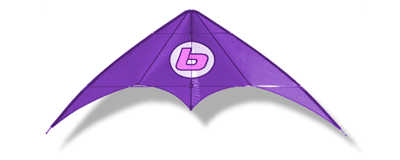
|
| Inner Space |
The trick revolution saw kites getting smaller, faster, more radical and extreme, but often at the cost of precision, stability and reliability. This wasn't a problem at first because we were all so happy doing tricks that we didn't care too much about anything else. If you wanted precision flying then there were kites like the Phantom Elite to cater for it.
When I competed in the UK Nationals in 1996 I was torn between a choice of kites. I wanted something that was stable and reliable, but I also wanted the capabilities of a dedicated trick kite that would allow me to include the kind of flying that I was best at. In short, I wanted the best of both worlds but I had to settle for one or the other.
The real benefit for me that came from competing was that it forced me to learn a more structured and disciplined style of flying. I didn't stick with it for more than a few years because structured and disciplined aren't things that I do well. But it did teach me about the importance of style as well as in-your-face technical skill.
Trick flying had been an exciting new territory for us and in our rush to get out and explore it we packed light and left a few things back home. In this case, we started to see more people flying tricks that were incredibly technical but just didn't look very good. To the untrained eye, it looked they were having trouble keeping the kite in the air, when in fact they were pulling off some incredible trick that actually required a great degree of skill and dexterity in controlling the kite.
So I pulled together these different influences and started to develop my own style. I tried to integrate tricks with more structured elements, always trying to let the composition unfold in a way that was pleasing to the hand and eye. Of course I didn't always get it right, but I was starting to get a better idea about what I should be doing.
I coined the phrase "Freestyle Flying" to describe what I meant by this fusion of tricks and structured flying that was evolving at the time. For me, the word "Freestyle" conjurs up the perfect image of combining freedom with style. Freedom to fly whatever way you like without the structure or rigourous demands of competition, but to do it with style. I summed it up in a post to rec.kites in February 1997.
|
|
These days, I rarely refer to myself as a "Trick Flier" or what I do as
"Trick Flying". It has this negative aura that conjurs up images of
someone standing in a field doing Axels and Flat Spins all days long.
This is not where I'm at and not where I'm going. "Freestyle Flying"
or "Freestyle Trick Flying" is the term I prefer and for me that means
the evolution of tricks and more traditional flying techniques into
an expressive and technically outstanding artform. It's more radical
and more trick-oriented than precision or ballet flying but it shares
in the same philosophy that any trick, figure or element in isolation
is nothing without the structure that encases it.
-- Andy Wardley
|

|
The Outer Space started as a prototype kite called the Phantom Freestyle that Tim made early in 1997. It was essentially a slightly smaller version of the Phantom Elite designed to bridge the freestyle gap between trick and precision flying. I flew it in competition that season and loved many things about it. You can read a post to rec.kites I made around that time.
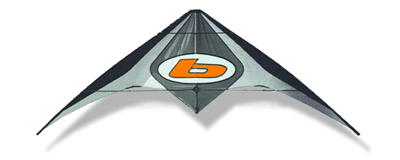
|
| Outer Space |
Over the course of that year and the first few months of 1998, the kite evolved into the Outer Space. Tim did most of the design work while I flew various test models and gave him my feedback. My main contribution to this kite was the that I designed for it. The kite was released in May 1998, as described in another post to rec.kites. This was, I believe, the first kite specifically designed for and marketed as a "freestyle kite". However, the phrase quickly caught on and became almost de facto overnight.
One thing that became apparent in the design of the Outer Space is that there is a very fine balance to be achieved between the two extremes of trick and precision. It takes an experienced kite designer of Tim Benson's pedigree to create something that treads the line so delicately. Having been witness to the evolution of this kite I was starting to understand the fundamental principles of kite design and recognise some of the constraints and limitations.
During the summer of 1998 I spent a lot of time thinking about the way in which airflow is distributed over the kite and how this affects its handling with regard to both precision and tricks. I figured that the time when you want the kite to be precise is when it is flying around the sky at speed. On the other hand, most tricks are performed when the kite is stalled or momentarily stopped. So if you can make a kite that is precise at high speed and radical at low speed then you should have everything you need.
Working out how to do this required an understanding of real and apparent wind. The real wind is the wind that blows on the face of a kite, typically at a speed of say, 5 to 15 mph. This causes the kite to accelerate forwards and fly around the sky, quickly reaching a top speed that would typically be several times the real wind speed, say 15 to 50 mph. The motion of the kite through the air creates apparent wind, exactly the same as the wind you feel when you put your hand (carefully) out of the window of a moving car. The apparent wind flows down the kite in the direction of travel, from nose to tail.
So when a kite is moving forwards and requires precision, the dominant airflow is the apparent wind running down the kite. But when the kite is slowed down or stopped to perform a trick, there is little or no apparent wind and the dominant force comes from the real wind blowing more directly onto the front face of the kite. I started thinking that a kite with two spines might be the way to go, providing a central channel that would act like a keel, keeping the kite on course when it moving forwards and reacting to the apparent wind. This stability at speed could be offset by curving up the leading edges to provide the radical rotation required of many tricks at low speed in the real wind.
And there was one trick in particular that the kite absolutely had to do: the Backspin. Andy Preston had been at it again and come up with the Stranger Level 7, an even more radical kite than the original Stranger. Although the SL7 didn't prove to be a lasting success, perhaps because it was so extreme to the point of being difficult to fly, it did excel at the Backspin and showed us something that we wanted in all our kites.
I made a few sketches of twin spine kites and felt encouraged enough by the idea to show it to Tim. In the week between christmas 1998 and the new year of 1999, Tim and I made the first few prototype test models of the kite that would eventually become the Gemini.
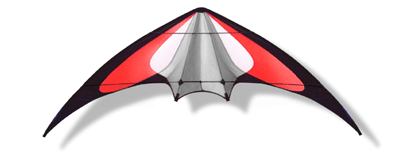
|
| Gemini |
When I flew the first prototype on that cold and wet December evening, I knew straight away that we were onto something. I remember this strange feeling of recognition flashing through my mind like fragments of a half remembered dream. Tim wasn't convinced at first but I managed to persuade him to make another prototype and give it a chance.
It took us several months and at least 15 test models before we started to get the basic shape right, and then another 10 or 15 for fine tuning. Only then did we start thinking about a design for the sail graphic and work on the panel layout. In the end it took a total of 43 prototypes before we reached the final production version.
The Gemini has proved to be everything that I want in a dual line freestyle kite. It has the radical capabilities of a dedicated trick kite like the Box of Tricks, but is also stable and predictable at speed, tracking straight lines well and carving nice smooth turns. It also has something of the laid back feel that I loved so much about the original Stranger, and it performs pretty much every trick in the book, including the Backspin which has become one of its defining hallmarks.
The Gemini turned out to be a big success and it remains one of the most popular choices for a freestyle kite. Over the winter of 2000/2001 we worked on the smaller brother of the Gemini, the Minigem. Designed for slightly higher winds and more radical tricks than the full size Gemini, the Minigem was launched in 2001.
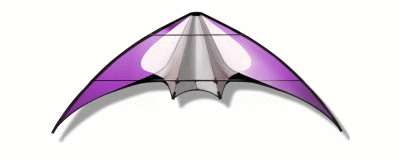
|
| Minigem |
In the early months of 2003, Tim worked on producing an ultralight version of the Gemini in response to continued demand. I can take no credit for the Gemini Ultralight, other than the fact that it is based on the original Gemini. It was Tim who did all the hard work here and I just had to fly a few kites and say which ones I like the best. Sometimes I think I must be the luckiest kite flier in the World to have someone like Tim Benson regularly sending me new kites like this to fall in love with...
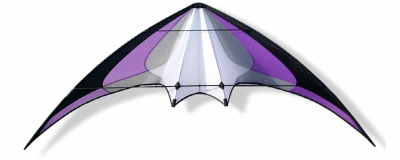
|
| Gemini Ultralight |
Creating an ultralight version of an existing kite is not a simple matter of putting some lighter spars in it. Doing so may reduce the overall weight of the kite, but it also changes the weight distribution and shifts the centre of gravity. It is particularly important for an ultralight kite designed for flying in light wind that the kite is balanced correctly. The process of trying out every combination of numerous different spars in various different parts of the kite can be painstakingly tedious. However it is critical in determining how well the kite will fly and how predictable it will be, especially in low wind conditions.
Tim Benson isn't the kind of person to settle for producing an ultralight version of a kite that just flies better in lighter wind. In this case, he also came up with a stunning new panel layout that compliments the original Gemini while providing its own clear identity.
The Deep Space is the latest (and dare we say greatest) kite to come out of the Benson workshop.
Tim starting playing around with some prototypes for this kite as far back as 2003. By the time of the Kite Party early in 2004 he had a handful of prototypes that he thought showed promise. Over the next 18 months we gradually refined the design making another forty-something test models in the process.
The kite was finally released, as promised, on a Tuesday some time shortly after lunch. The Tuesday in question was the 26th of July, 2005 and the time around 1.20pm.
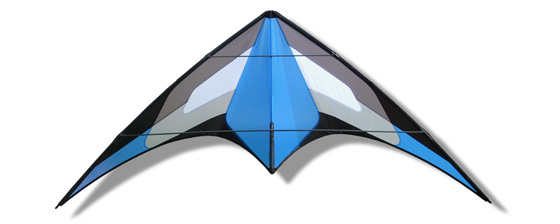
|
| Deep Space |
I flew the Gemini almost exclusively for 3 or 4 years after it was released. It was everything I wanted in a dual line kite and I couldn't think of any way to improve upon it (not until a few years after that when we designed the Deep Space, see above).
So I turned my attention to quad line kites. I had dabbled with kites like the Revolution but hadn't really taken to them in the same way that I had with dual line kites. They are somewhat harder to fly and don't provide the thrilling feel that a two line kite gives as it carves a turn through the air. For me they lack the freestyle nature and don't really offer much in the way of trick capabilities, although there are plenty of skilled Revolution fliers that would disagree with me on that.
I starting to think about something that was a hybrid between existing two and four line kites. Something that would provide the additional control that four lines bring, but with a shape that provides channels to separate the airflow and give the two line feeling of carving turns. I thought it should be symmetrical so that it would fly equally well both forwards and backwards, and of course I wanted something that would do tricks.
I made one symmetrical quad line kite but it was very floppy and hard to control. The wind would catch behind one half of it and twist it up into a big mess. I needed something to make the kite more rigid and stabilise the structure. This was also going to be crucial for freestyle and trick flying where rigid kites with taught sails generally perform better than loose and baggy ones.
I played around with a few ideas for a year or so but didn't really come up with anything interesting. Then at the end of the summer of 2002 I was inspired by a tetrahedral kite of the kind invented by Alexander Graham Bell. I remembered that the tetrahedron is the most stable 3D shape, being as it is the smallest and simplest of the platonic solids. It is effectively the three dimensional equivalent of a triangle, which is of course the most stable minimal shape in two dimensions. Tetrahedal kites are simple, self-supporting and can be scaled up to almost any practical size. It was this characteristic that led Graham Bell to use huge tetrahedral kites to life radio antennae.
At the Bristol kite festival at the start of September 2002, I was showing Tim Benson a tetrahedral kite and telling him about my ideas for a new kind of kite. At that time I still wasn't exactly sure what it would look like, but I knew that it should have a 3D shape and that the tetrahedral kite was the key.
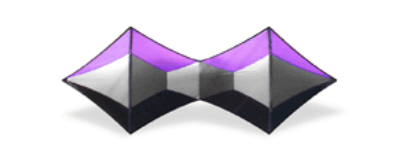
|
| Airbow |
Inspiration struck at some point in the next 24 hours, and the following evening I made the first prototype of the Airbow. I flew it the following night and discovered that I had designed it back-to-front. I originally thought it would fly with the main spreader closer to the flier with the stand-offs pushing the sail away. However, it quickly became apparent that it flew much better with the spreader at the back and the sail pushed towards the flier. These things happen when you're designing kites, but it's always best to make your biggest mistakes (and thereby learn the most important lessons) early on in the design process.
I made another larger prototype and took them both away on holiday for a couple of weeks. By the time I returned I was convinced that I was onto something good.
I made a dozen or so prototypes over the winter of 2002/2003. In May 2003 Wired magazine had got hold of the story and ran an article on it. It was also around this time that Tim started getting involved in the design. Although I had got the basic shape right by this time (while Tim had been busy working on the Ultralight Gemini), there is a vast difference between a prototype kite and a production kite. This is, of course, where Tim's brilliance shines through. Over the next six months we finalised the shape, materials and design for the panel layout and created the kite that you see before you today. You can read the rec.kites post that I made announcing the kite and describing a little more about what makes it special.
The Airbow is more than just a new quad line kite. It is a new kind of kite that exploits the principles of tensegrity to achieve the rigidity and stability of the basic shape. The compressive forces of the spars pushing outwards are balanced by the tensile forces of the sail pulling inwards. The result is a strong, light and stable minimal structure.
The Airbow has since appeared on TV as part of the Daily Planet program on the Discovery Channel, and then was listed as one of the coolest inventions of 2003 by Time Magazine. There is a dedicated website for the Airbow which has more information about the kite and links to these and other places.